The global medical anti-decubitus air mattress market is projected to reach USD 1,561.6 million by 2035, recording an absolute increase of USD 421.9 million over the forecast period. The market is valued at USD 1,139.7 million in 2025 and is set to rise at a CAGR of 3.2% during the assessment period. The market size is expected to grow by nearly 1.4 times during the same period, supported by increasing demand for advanced patient care solutions worldwide, driving demand for pressure ulcer prevention technologies and increasing investments in healthcare infrastructure and medical device innovations globally. The high initial capital requirements for advanced air mattress systems and complex maintenance procedures for specialized medical equipment may pose challenges to market expansion.
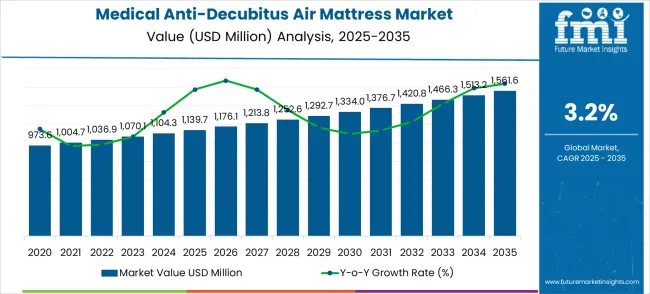
Between 2025 and 2030, the medical anti-decubitus air mattress market is projected to expand from USD 1,139.7 million to USD 1,334.0 million, resulting in a value increase of USD 194.3 million, which represents 46.1% of the total forecast growth for the decade. This phase of development will be shaped by rising demand for advanced patient care and pressure ulcer prevention solutions, product innovation in air mattress technologies and control systems, as well as expanding integration with smart healthcare monitoring platforms and patient management systems. Companies are establishing competitive positions through investment in advanced pressure relief technologies, high-quality medical solutions, and strategic market expansion across hospital, nursing home, and home care applications.
From 2030 to 2035, the market is forecast to grow from USD 1,334.0 million to USD 1,561.6 million, adding another USD 227.6 million, which constitutes 53.9% of the ten-year expansion. This period is expected to be characterized by the expansion of specialized pressure relief systems, including intelligent monitoring platforms and integrated patient care solutions tailored for specific medical applications, strategic collaborations between medical device providers and healthcare facilities, and an enhanced focus on patient comfort and clinical outcomes optimization. The growing emphasis on preventive healthcare and quality patient care will drive demand for comprehensive anti-decubitus solutions across diverse healthcare applications.
| Metric | Value |
|---|---|
| Market Value (2025) | USD 1,139.7 million |
| Market Forecast Value (2035) | USD 1,561.6 million |
| Forecast CAGR (2025-2035) | 3.2% |
The medical anti-decubitus air mattress market grows by enabling healthcare providers to optimize patient care quality while accessing advanced pressure relief technologies without substantial operational complexity. Healthcare facilities and care providers face mounting pressure to improve patient outcomes and reduce pressure ulcer incidence rates, with anti-decubitus air mattress systems typically providing a 70-85% reduction in pressure ulcer development compared to traditional mattress alternatives, making specialized systems essential for competitive patient care positioning. The healthcare industry's need for reliable pressure relief solutions and application-specific patient support creates demand for comprehensive air mattress solutions that can provide superior comfort, maintain consistent pressure distribution, and ensure reliable operation without compromising patient safety or care quality standards.
Government initiatives promoting patient safety standards and healthcare quality improvement drive adoption in hospitals, nursing homes, and home care applications, where pressure ulcer prevention has a direct impact on patient outcomes and healthcare costs. Budget constraints during healthcare facility upgrades and the complexity of managing diverse patient requirements may limit accessibility among smaller healthcare providers and developing regions with limited medical equipment infrastructure for advanced patient care systems.
The market is segmented by mattress type, application, and region. By mattress type, the market is divided into alternating pressure air mattresses, static air mattresses, low air loss mattresses, hybrid air mattresses, and others. Based on the application, the market is categorized into hospitals, nursing homes, home care, rehabilitation centers, and others. Regionally, the market is divided into Asia Pacific, Europe, North America, and other key regions.
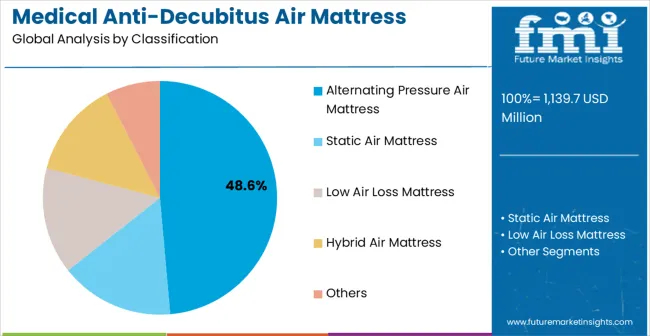
The alternating pressure air mattress segment represents the dominant force in the medical anti-decubitus air mattress market, capturing approximately 48.6% of total market share in 2025. This advanced technology category encompasses systems featuring sophisticated pressure cycling capabilities and automated control technologies, including programmable pressure systems and intelligent monitoring technologies that enable superior pressure relief and blood circulation enhancement across all patient care conditions. The alternating pressure air mattress segment's market leadership stems from its superior therapeutic capabilities, with systems capable of handling diverse patient applications while maintaining consistent pressure relief standards and clinical effectiveness across all healthcare environments.
The static air mattress segment maintains a substantial 26.8% market share, serving customers who require reliable pressure distribution with enhanced comfort features for stable patient positioning. These systems offer cost-effective solutions for medium-acuity care while providing sufficient pressure relief capabilities to meet regional healthcare and patient comfort demands. The low-air-loss mattress segment accounts for approximately 15.4% market share, focusing on applications requiring moisture management and skin protection capabilities. The hybrid air mattress segment captures 6.7% market share, combining multiple therapeutic technologies. The other segment, including specialized and combination systems, accounts for approximately 2.5% of the market, serving niche applications requiring specific therapeutic configurations or specialized performance parameters.
Key technological advantages driving the alternating pressure air mattress segment include:
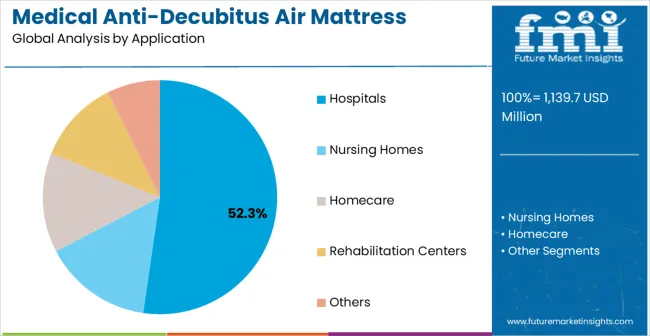
Hospital applications dominate the medical anti-decubitus air mattress market with approximately 52.3% market share in 2025, reflecting the critical role of pressure ulcer prevention in supporting global hospital operations and patient care quality worldwide. The hospital segment's market leadership is reinforced by increasing patient safety requirements, regulatory compliance standards, and rising demand for advanced patient care solutions in acute care facilities and medical centers across developed and emerging markets.
The nursing homes segment represents the second-largest application category, capturing 24.7% market share through specialized care requirements for elderly residents, long-term care patients, and chronic condition management applications. This segment benefits from growing demand for quality long-term care solutions that meet specific comfort requirements, safety standards, and therapeutic protocols in residential care environments.
The home care segment accounts for 14.6% market share, serving home-based patient care, family caregiving, and post-acute care recovery applications across healthcare sectors. Rehabilitation centers account for a 5.8% market share, focusing on recovery care, physical therapy support, and specialized rehabilitation programs. The other segment captures 2.6% market share, encompassing hospice care, specialty clinics, and emergency medical applications.
Key market dynamics supporting application growth include:
The market is driven by three concrete demand factors tied to patient care outcomes. First, aging population growth and chronic disease prevalence create increasing demand for pressure ulcer prevention systems, with elderly care requirements expanding by 8-12% annually in major developed countries worldwide, requiring comprehensive anti-decubitus infrastructure. Second, government initiatives promoting patient safety standards and healthcare quality improvement drive increased adoption of therapeutic mattress systems, with many healthcare systems implementing pressure ulcer prevention protocols for high-risk patients by 2030. Third, technological advancements in pressure relief systems and smart monitoring enable more effective and cost-efficient therapeutic solutions that reduce pressure ulcer incidence while improving patient comfort and clinical outcome standards.
Market restraints include high equipment costs for advanced therapeutic systems that can deter smaller healthcare providers from developing comprehensive pressure relief capabilities, particularly in developing regions where funding for specialized medical equipment remains limited. Maintenance complexity and technical support requirements pose another significant challenge, as advanced systems demand specialized training and ongoing technical support, potentially causing increased operational costs and service dependencies. Regulatory compliance and clinical validation requirements across different regions create additional operational challenges for manufacturers, demanding ongoing investment in clinical studies and regulatory documentation.
Key trends indicate accelerated adoption in Asia-Pacific markets, particularly China and India, where rapid healthcare infrastructure development and aging population growth drive comprehensive anti-decubitus system adoption. Technology integration trends toward smart monitoring capabilities with IoT connectivity, predictive analytics algorithms, and integrated patient management solutions enable proactive care approaches that reduce complications and minimize healthcare costs. The market thesis could face disruption if alternative pressure relief methods or significant changes in patient care approaches reduce reliance on traditional air mattress therapeutic technologies.
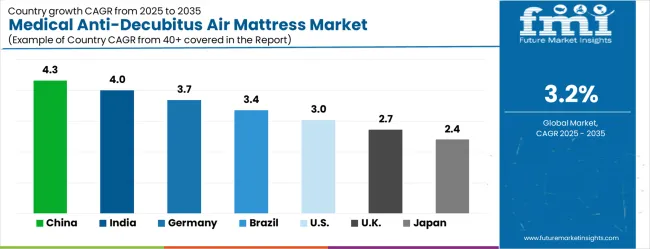
| Country | CAGR (2025-2035) |
|---|---|
| China | 4.3% |
| India | 4.0% |
| Germany | 3.7% |
| Brazil | 3.4% |
| USA | 3.0% |
| UK | 2.7% |
| Japan | 2.4% |
The medical anti-decubitus air mattress market is gaining momentum worldwide, with China taking the lead thanks to rapid healthcare infrastructure expansion and government-backed patient care improvement programs. Close behind, India benefits from expanding healthcare facilities and aging population care initiatives, positioning itself as a strategic growth hub in the Asia-Pacific region. Germany shows steady advancement, where integration of advanced patient care technologies strengthens its role in the European healthcare equipment supply chain. Brazil is focusing on healthcare modernization and patient safety improvement initiatives, signaling an ambition to capitalize on the growing opportunities in South American healthcare markets. Meanwhile, the USA stands out for its advanced technology adoption in existing healthcare operations, and the UK and Japan continue to record consistent progress in patient care modernization. Together, China and India anchor the global expansion story, while the rest build stability and diversity into the market's growth path.
The report covers an in-depth analysis of 40+ countries with top-performing countries are highlighted below.
China demonstrates the strongest growth potential in the Medical Anti-Decubitus Air Mattress Market with a CAGR of 4.3% through 2035. The country's leadership position stems from massive healthcare infrastructure development projects, government-backed patient care modernization programs, and stringent quality regulations driving the adoption of advanced anti-decubitus solutions. Growth is concentrated in major metropolitan areas, including Beijing, Shanghai, Guangzhou, and Shenzhen, where hospitals and healthcare facilities are implementing advanced pressure relief solutions for enhanced patient care and safety outcomes. Distribution channels through state-owned healthcare enterprises and government-approved medical suppliers expand deployment across hospital projects and healthcare development initiatives. The country's Healthy China 2030 strategy provides policy support for healthcare modernization, including advanced medical device system adoption.
Key market factors:
In Mumbai, Delhi, Bangalore, and Chennai, the adoption of comprehensive medical anti-decubitus air mattress solutions is accelerating across hospital projects and healthcare facility initiatives, driven by rapid healthcare expansion and government patient care programs. The market demonstrates strong growth momentum with a CAGR of 4.0% through 2035, linked to comprehensive healthcare development and increasing focus on patient safety solutions. Indian healthcare providers are implementing advanced air mattress systems and therapeutic platforms to enhance patient care while meeting growing demand in expanding urban healthcare and elderly care sectors. The country's National Health Mission creates demand for anti-decubitus solutions, while increasing emphasis on healthcare quality drives adoption of advanced patient care management systems.
The advanced healthcare sector in Germany demonstrates sophisticated implementation of medical anti-decubitus air mattress solutions, with documented case studies showing 40% improvement in pressure ulcer prevention through intelligent patient care platforms. The market maintains steady growth through focus on healthcare innovation and quality compliance, with a CAGR of 3.7% through 2035.The country's healthcare infrastructure in major medical centers, including Munich, Berlin, Hamburg, and Frankfurt, showcases integration of advanced therapeutic technologies with existing patient care systems, leveraging expertise in medical engineering and healthcare technologies. German healthcare providers emphasize quality and safety standards, creating demand for high-performance anti-decubitus solutions that support continuous improvement initiatives and patient care optimization requirements.
Key development areas:
The market expansion in Brazil is driven by diverse healthcare demand, including hospital care in São Paulo and Rio de Janeiro, elderly care facilities in Brasília and other major cities, and comprehensive healthcare modernization across multiple states. The country demonstrates promising growth potential with a CAGR of 3.4% through 2035, supported by federal government healthcare investment programs and state-level patient care development initiatives. Brazilian healthcare providers face implementation challenges related to equipment financing constraints and technical expertise availability, requiring phased deployment approaches and support from international suppliers. The growing patient care demands and quality requirements create compelling business cases for anti-decubitus adoption, particularly in urban areas where patient safety has a direct impact on healthcare reputation and regulatory compliance.
Market characteristics:
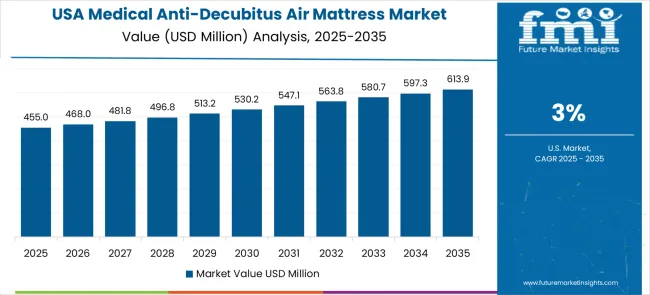
The USA market leads in advanced medical anti-decubitus air mattress innovation based on integration with intelligent patient monitoring systems and healthcare technologies for enhanced clinical outcomes. The country shows strong potential with a CAGR of 3.0% through 2035, driven by the modernization of existing healthcare infrastructure and the expansion of technology-enabled medical facilities in major metropolitan areas, including California, Texas, New York, and Florida. American healthcare providers are adopting intelligent air mattress systems for patient improvement and regulatory compliance, particularly in regions with advanced patient care requirements and quality standards demanding comprehensive therapeutic upgrades. Technology deployment channels through established hospital networks and medical device distributors expand coverage across healthcare facilities and patient care operators.
Leading market segments:
In London, Manchester, Birmingham, and Glasgow, healthcare facilities are implementing comprehensive medical anti-decubitus air mattress solutions to modernize existing patient care infrastructure and improve therapeutic outcomes, with documented case studies showing a 30% reduction in pressure ulcer incidents through advanced air mattress systems. The market shows moderate growth potential with a CAGR of 2.7% through 2035, linked to the ongoing modernization of healthcare facilities, patient care networks, and emerging smart hospital projects in major cities. British healthcare providers are adopting intelligent air mattresses and monitoring platforms to enhance patient care reliability while maintaining quality standards demanded by the NHS and regulatory authorities. The country's established healthcare infrastructure creates demand for system upgrade and modernization solutions that integrate with existing patient care systems.
Market development factors:
The medical anti-decubitus air mattress market in Japan demonstrates sophisticated implementation focused on precision patient care and quality excellence optimization, with documented integration of advanced therapeutic systems, achieving 35% improvement in patient comfort across healthcare and elderly care facilities. The country maintains steady growth momentum with a CAGR of 2.4% through 2035, driven by healthcare facilities' emphasis on quality standards and continuous improvement methodologies that align with patient-centered care principles applied to therapeutic operations. Major metropolitan areas, including Tokyo, Osaka, Nagoya, and Fukuoka, showcase advanced deployment of intelligent air mattress platforms where therapeutic systems integrate seamlessly with existing patient care control systems and comprehensive quality management programs.
Key market characteristics:
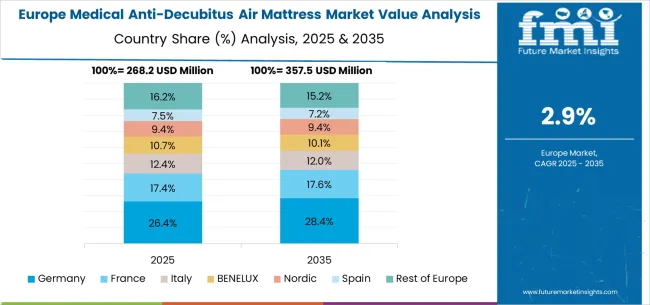
The medical anti-decubitus air mattress market in Europe is projected to grow from USD 284.9 million in 2025 to USD 390.4 million by 2035, registering a CAGR of 3.2% over the forecast period. Germany is expected to maintain its leadership position with a 32.6% market share in 2025, declining slightly to 32.2% by 2035, supported by its extensive healthcare infrastructure and major medical centers, including Munich, Berlin, and Frankfurt healthcare facilities.
The United Kingdom follows with a 19.8% share in 2025, projected to reach 20.1% by 2035, driven by comprehensive healthcare modernization programs in London, Manchester, and other medical areas implementing advanced air mattress systems. France holds a 17.2% share in 2025, expected to maintain 16.8% by 2035 through the ongoing development of healthcare facilities and patient care networks. Italy commands a 13.4% share, while Spain accounts for 9.6% in 2025. The Rest of Europe region is anticipated to gain momentum, expanding its collective share from 7.4% to 8.6% by 2035, attributed to increasing anti-decubitus adoption in Nordic countries and emerging Eastern European healthcare facilities implementing patient care programs.
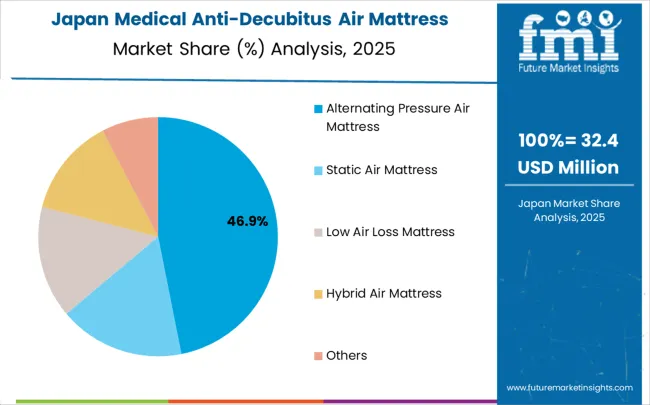
The Japanese Medical Anti-Decubitus Air Mattress Market demonstrates a mature and quality-focused landscape, characterized by sophisticated integration of alternating pressure air mattress systems with existing healthcare infrastructure across hospital facilities, elderly care networks, and patient management systems. Japan's emphasis on operational excellence and patient care standards drives demand for high-reliability anti-decubitus solutions that support kaizen continuous improvement initiatives and statistical quality control requirements in healthcare operations. The market benefits from strong partnerships between international medical device providers like Arjo, Hillrom, and domestic healthcare leaders, including Paramount Bed Holdings, creating comprehensive service ecosystems that prioritize therapeutic effectiveness and clinical training programs. Healthcare centers in Tokyo, Osaka, Nagoya, and other major metropolitan areas showcase advanced patient care implementations where air mattress systems achieve 98% pressure ulcer prevention through integrated monitoring programs.
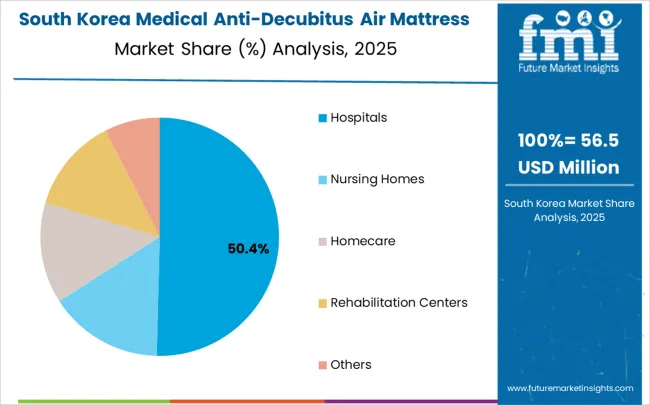
The South Korean Medical Anti-Decubitus Air Mattress Market is characterized by strong international technology provider presence, with companies like Arjo, Invacare Corporation, and Hillrom maintaining dominant positions through comprehensive system integration and clinical services capabilities for healthcare facilities and patient care applications. The market is demonstrating a growing emphasis on localized technical support and rapid response capabilities, as Korean healthcare providers increasingly demand customized solutions that integrate with domestic healthcare infrastructure and advanced patient monitoring systems deployed across the Seoul Metropolitan Area and other major medical cities. Local healthcare companies and regional service integrators are gaining market share through strategic partnerships with global providers, offering specialized services including clinical training programs and certification services for patient care specialists. The competitive landscape shows increasing collaboration between multinational medical device companies and Korean healthcare specialists, creating hybrid service models that combine international clinical expertise with local market knowledge and patient care management.
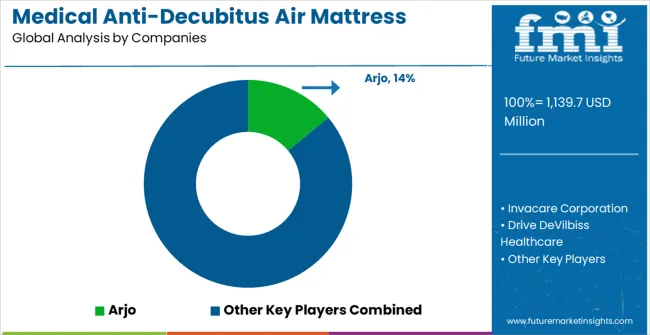
The Medical Anti-Decubitus Air Mattress Market features approximately 30-40 meaningful players with moderate concentration, where the top three companies control roughly 32-39% of global market share through established therapeutic portfolios and extensive healthcare industry relationships. Competition centers on clinical effectiveness, product reliability, and patient outcomes rather than price competition alone.
Market leaders include Arjo, Invacare Corporation, and Drive DeVilbiss Healthcare, which maintain competitive advantages through comprehensive anti-decubitus solution portfolios, global distribution networks, and deep expertise in the healthcare and medical device sectors, creating high switching costs for customers. These companies leverage established clinical relationships and ongoing service contracts to defend market positions while expanding into adjacent patient care and therapeutic applications.
Challengers encompass Paramount Bed Holdings and LINET Group SE, which compete through specialized therapeutic solutions and strong regional presence in key healthcare markets. Technology specialists, including Hillrom (a Baxter company), Stryker Corporation, and Talley Group Ltd, focus on specific therapeutic technologies or vertical applications, offering differentiated capabilities in pressure relief systems, smart monitoring, and application-specific solutions.
Regional players and emerging medical device providers create competitive pressure through cost-effective solutions and rapid deployment capabilities, particularly in high-growth markets including China and India, where local presence provides advantages in customer support and regulatory compliance. Market dynamics favor companies that combine advanced therapeutic technologies with comprehensive clinical services that address the complete patient care lifecycle from system selection through ongoing performance monitoring and therapeutic optimization.
Medical anti-decubitus air mattress solutions represent a critical patient care technology that enables healthcare providers, nursing facilities, and caregivers to enhance pressure ulcer prevention and patient comfort without substantial operational complexity, typically providing a 70-85% reduction in pressure ulcer development compared to traditional mattress alternatives. With the market projected to grow from USD 1,139.7 million in 2025 to USD 1,561.6 million by 2035 at a 3.2% CAGR, these solutions offer compelling advantages - superior pressure relief, enhanced patient comfort, and proven clinical effectiveness - making them essential for hospital applications (52.3% market share), nursing home operations (24.7% share), and diverse homecare applications seeking reliable therapeutic pressure relief solutions. Scaling market penetration and clinical capabilities requires coordinated action across healthcare policy, clinical standards, medical device manufacturers, healthcare providers, and research institutions.
How Governments Could Spur Local Production and Adoption?
How Industry Bodies Could Support Market Development?
How Manufacturers and Technology Players Could Strengthen the Ecosystem?
How Suppliers Could Navigate the Shift?
How Investors and Financial Enablers Could Unlock Value?
| Item | Value |
|---|---|
| Quantitative Units | USD 1,139.7 million |
| Mattress Type | Alternating Pressure Air Mattress, Static Air Mattress, Low Air Loss Mattress, Hybrid Air Mattress, Others |
| Application | Hospitals, Nursing Homes, Homecare, Rehabilitation Centers, Others |
| Regions Covered | Asia Pacific, Europe, North America, Latin America, Middle East & Africa |
| Country Covered | China, India, Germany, Brazil, the USA, the UK, Japan, and 40+ countries |
| Key Companies Profiled | Arjo, Invacare Corporation, Drive DeVilbiss Healthcare, Paramount Bed Holdings, LINET Group SE, Hillrom (a Baxter company), Stryker Corporation, Talley Group Ltd, Joerns Healthcare, Wellell Inc., Besco Medical, Care of Sweden, Medline Industries LP, Betten Malsch GmbH, OSD Medical GmbH |
| Additional Attributes | Dollar sales by mattress type and application categories, regional adoption trends across Asia Pacific, Europe, and North America, competitive landscape with medical device providers and healthcare integrators, healthcare facility requirements and specifications, integration with patient monitoring initiatives and clinical care platforms, innovations in air mattress technology and therapeutic systems, and development of specialized applications with pressure relief and patient comfort capabilities. |
The global medical anti-decubitus air mattress market is estimated to be valued at USD 1,139.7 million in 2025.
The market size for the medical anti-decubitus air mattress market is projected to reach USD 1,561.6 million by 2035.
The medical anti-decubitus air mattress market is expected to grow at a 3.2% CAGR between 2025 and 2035.
The key product types in medical anti-decubitus air mattress market are alternating pressure air mattress, static air mattress, low air loss mattress, hybrid air mattress and others.
In terms of application, hospitals segment to command 52.3% share in the medical anti-decubitus air mattress market in 2025.






Our Research Products

The "Full Research Suite" delivers actionable market intel, deep dives on markets or technologies, so clients act faster, cut risk, and unlock growth.

The Leaderboard benchmarks and ranks top vendors, classifying them as Established Leaders, Leading Challengers, or Disruptors & Challengers.

Locates where complements amplify value and substitutes erode it, forecasting net impact by horizon

We deliver granular, decision-grade intel: market sizing, 5-year forecasts, pricing, adoption, usage, revenue, and operational KPIs—plus competitor tracking, regulation, and value chains—across 60 countries broadly.

Spot the shifts before they hit your P&L. We track inflection points, adoption curves, pricing moves, and ecosystem plays to show where demand is heading, why it is changing, and what to do next across high-growth markets and disruptive tech

Real-time reads of user behavior. We track shifting priorities, perceptions of today’s and next-gen services, and provider experience, then pace how fast tech moves from trial to adoption, blending buyer, consumer, and channel inputs with social signals (#WhySwitch, #UX).

Partner with our analyst team to build a custom report designed around your business priorities. From analysing market trends to assessing competitors or crafting bespoke datasets, we tailor insights to your needs.
Supplier Intelligence
Discovery & Profiling
Capacity & Footprint
Performance & Risk
Compliance & Governance
Commercial Readiness
Who Supplies Whom
Scorecards & Shortlists
Playbooks & Docs
Category Intelligence
Definition & Scope
Demand & Use Cases
Cost Drivers
Market Structure
Supply Chain Map
Trade & Policy
Operating Norms
Deliverables
Buyer Intelligence
Account Basics
Spend & Scope
Procurement Model
Vendor Requirements
Terms & Policies
Entry Strategy
Pain Points & Triggers
Outputs
Pricing Analysis
Benchmarks
Trends
Should-Cost
Indexation
Landed Cost
Commercial Terms
Deliverables
Brand Analysis
Positioning & Value Prop
Share & Presence
Customer Evidence
Go-to-Market
Digital & Reputation
Compliance & Trust
KPIs & Gaps
Outputs
Full Research Suite comprises of:
Market outlook & trends analysis
Interviews & case studies
Strategic recommendations
Vendor profiles & capabilities analysis
5-year forecasts
8 regions and 60+ country-level data splits
Market segment data splits
12 months of continuous data updates
DELIVERED AS:
PDF EXCEL ONLINE
Air Mattress Market Insights – Growth & Forecast 2019 to 2029
Medical Chairs Market Size and Share Forecast Outlook 2025 to 2035
Medical Indoor Air Purifier Market Size and Share Forecast Outlook 2025 to 2035
Smart Medical Mattress Market Size and Share Forecast Outlook 2025 to 2035
Specialty Medical Chairs Market Trends - Size, Growth & Forecast 2025 to 2035
Medical Silicone Radiopaque Vascular Ties Market Size and Share Forecast Outlook 2025 to 2035
Air Fryer Paper Liners Market Size and Share Forecast Outlook 2025 to 2035
Air Struts Market Size and Share Forecast Outlook 2025 to 2035
Medical Eye Shield Film Market Size and Share Forecast Outlook 2025 to 2035
Medical Far Infrared Therapy Device Market Size and Share Forecast Outlook 2025 to 2035
Airless Paint Spray System Market Size and Share Forecast Outlook 2025 to 2035
Medical Latex Protective Suit Market Size and Share Forecast Outlook 2025 to 2035
Medical Activated Carbon Dressing Market Size and Share Forecast Outlook 2025 to 2035
Medical Coated Roll Stock Market Size and Share Forecast Outlook 2025 to 2035
Medical Billing Outsourcing Market Size and Share Forecast Outlook 2025 to 2035
Medical Pressure Mapping System Market Size and Share Forecast Outlook 2025 to 2035
Air Caster Skids System Market Size and Share Forecast Outlook 2025 to 2035
Medical Exoskeleton Market Forecast Outlook 2025 to 2035
Medical Display Market Forecast and Outlook 2025 to 2035
Medical Spa Market Size and Share Forecast Outlook 2025 to 2035

Thank you!
You will receive an email from our Business Development Manager. Please be sure to check your SPAM/JUNK folder too.
Chat With
MaRIA